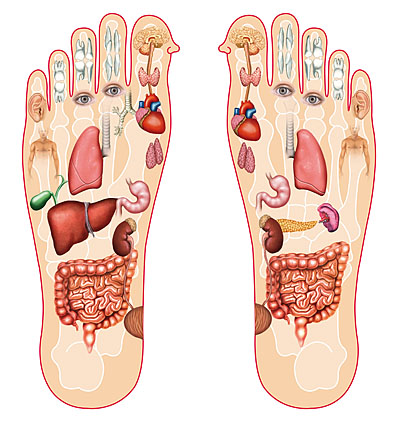 During the Tang dynasty, reflexology was introduced to Japan; During the Yuan dynasty it was introduced to Europe. Although Reflexology originated in China, it was not widely practiced in China, because of political turmoil and natural disasters in Chinese history, and this cultural heritage almost disappeared. At the beginning of the twentieth century, American physician Dr. William Fitzgerald, using modern medical methods, studied and documented Zone Therapy, which popularized the principles of Reflexology in the United States.
During the Tang dynasty, reflexology was introduced to Japan; During the Yuan dynasty it was introduced to Europe. Although Reflexology originated in China, it was not widely practiced in China, because of political turmoil and natural disasters in Chinese history, and this cultural heritage almost disappeared. At the beginning of the twentieth century, American physician Dr. William Fitzgerald, using modern medical methods, studied and documented Zone Therapy, which popularized the principles of Reflexology in the United States.
Today our lack of health is mainly due to our lack of exercise. In ancient times the majority of people work all day barefoot in the fields where the foot is in direct contact with the ground, and thus the acupuncture points of the body were stimulated, promoting circulation. Sweating prompted people to drink a lot of water, promoting a healthy metabolic cycle, so in ancient time people were healthier.
Reflexology uses the principle of stimulation of reflex zones in the foot to treat ailments. By massaging the reflex zone of an ailing organ or muscle, we restore the original function of that organ or muscle to achieve a therapeutic effect in a natural way.
Through the process of metabolism, our body gets rid of waste and toxins accumulated in the body's lymphatic system, kidneys, large intestine and skin. If these organs are dysfunctional, the body is unable to expel wastes and toxins, and we become ill. By stimulating the reflex zones, Reflexology promotes the blood circulation of these organs, restoring their normal function and eliminating the wastes and toxins accumulated in the body.
In fact, not all physical discomforts are due to illness. If the discomfort is not too serious, you do not have to take medication, as long as you adjust your lifestyle to become healthier, coupled with proper exercise and stress management, with perseverance, you can restore your health in a natural way. If in addition you can receive reflexology therapy to improve blood circulation, you will recover faster with less effort.
Based on many years of clinical experience, Reflexology has the following benefits:
- Promote unencumbered blood circulation.
- Help the human energy cycle pipelines get rid of obstacles.
- Promote the normal function of organs and enhance cooperation between organs.
- Improve endocrine balance, to ease tensions in the system.
- Expel wastes and toxins from the body.
- Strengthen metabolism to maintain youthful vitality.
- Stimulate the cells to produce energy and prevent aging.
- Restore degraded organ functions and prevent illnesses.
- Cure ailments effectively in a natural way.
Usually a session of reflexology takes about 30 to 40 minutes. If a person is physically weak or cannot stand the pain, he should reduce the massage duration. For people with serious heart or kidney illness, they should limit the massage time to about three to five minutes.
The following are common reactions to Reflexology:
- Fatigue: After the massage if you feel tired, you should rest. The massage enhances blood circulation, which may create some physical fatigue, making it easier to fall asleep. The length of the fatigue varies from person to person according to each person's physical condition.
- Dry mouth: not everyone will feel thirsty, but the occurrence of thirst is normal, as long as you drink plenty of water after the massage.
- Soreness: Some location where soreness was never experienced may feel sore after the massage, this is because the spot had lurking problems for some time, or had previously been ill. After stimulation by massage, the problem is revealed. The soreness should disappear in 3-5 days.
- Appetite: After receiving massage for about a week, the person ‘s appetite will slowly increase, this is a normal reaction.
- Palms sweat or body sweat: the first time a person receives foot massage, he might be nervous, which causes sweating. In this case, try to relax as much as possible.
- Change of color of urine: for someone with serious illness, after a few days of receiving massage, the person’s urine may appear opaque or yellow or contain white secretions. This is due to wastes or toxins being released after the massage.
- Comfort, relaxation, good sleep quality: This is what most people experience after receiving foot massage, because after a massage, blood circulation is increased, so that you feel comfortable, relaxed, and it is easier to fall asleep at night.
After a foot massage, reflex zones are stimulated, causing wastes and toxins accumulated in the corresponding organs to be excreted through the kidney, ureter and bladder. Therefore, after each reflexology session, it is recommended to drink 10 to 17 oz. of water so that wastes and toxins can be expelled, otherwise the efficiency of the foot massage will be significantly lowered.